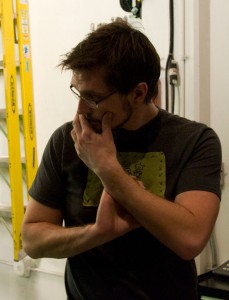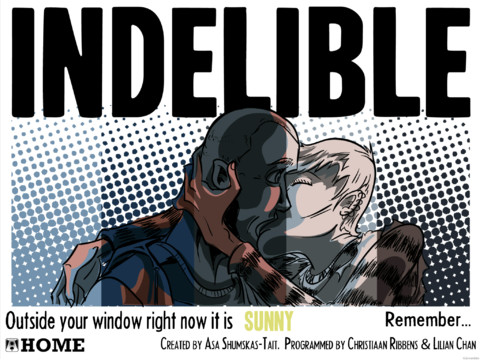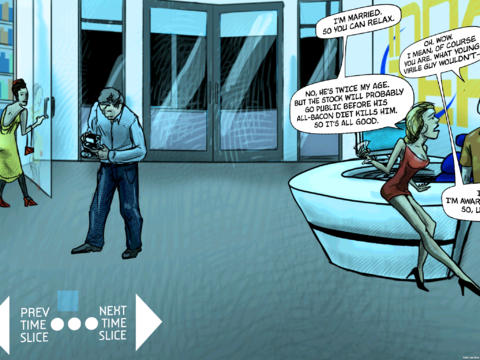“We wanted to start a conversation about what was possible with digital delivery that was still inherently a comic” Asa Shumskas-Tait tells about the inspiration behind the Re:Active comic app
![]() We’re always excited by new methods of digital story-telling here at Pipedream Comics, and so our curiosity was piqued last week when we heard about the brilliant Re:Active app from Psychic Bunny. Offering a really original approach to digital story-telling by using some of the iPad’s internal features (like the accelerometer) to develop stories you read by interacting with them. To find out more about how this exciting project came about we contacted writer and artist Asa Shumskas Tait to get the lowdown.
We’re always excited by new methods of digital story-telling here at Pipedream Comics, and so our curiosity was piqued last week when we heard about the brilliant Re:Active app from Psychic Bunny. Offering a really original approach to digital story-telling by using some of the iPad’s internal features (like the accelerometer) to develop stories you read by interacting with them. To find out more about how this exciting project came about we contacted writer and artist Asa Shumskas Tait to get the lowdown.
Tell us a bit about the inspiration for Re:Active? And who makes up the Re:Active team?

AST: At the time we created Re:Active the bulk of digital comics were either print comics turned into PDF or motion comics, which are basically just bad animation. We wanted to start a conversation about what was possible with digital delivery that was still inherently a comic. That’s why the app is free free to download, because the main idea was to show people that they could do a lot more and hopefully start people thinking down new avenues. So the goal was to tell stories that didn’t just have interactive features grafted on, but simply couldn’t be told on paper. We just started thinking about what was possible and ended up doing three short stories that each feature a different mechanic as part of the storytelling.
Since then a ton of innovative work in delivery and pacing has been coming out, and its awesome to see the space develop like that. Still, I think Re:Active stands apart from a lot of what’s out there because it’s built in the Unity game engine, so we’re using functionality, like 3D environments and location-based weather data, that aren’t available through something like Comixology.
Our core team was me (writing “Indelible” and “Tilt,” and art for all three shorts), Jesse Vigil (writing “Qualia“), Diana Hughes (Interactive Producer), Lilian Chan (Unity Engineer), and Louis Strongin (3D setups for “Qualia“).
Tell us a bit about you. Do you come from a comics background or an app development background?
AST: I come from a comics and filmmaking background, and Jesse really has the interactive background, so it was a great collaboration. We have a small production company called Psychic Bunny here in Los Angeles, and worked on Re:Active as a passion project in between other work.
Which did you start out wanting to make, an app or a comic? Did you create stories to match the technology or did you know the kind of story you wanted to tell and then developed for the technology accordingly?
AST: Really we started with the idea that the best way to move the digital comics ball forward was to make a comic that HAD to be delivered as an app. You can’t really experience the stories in Re:Active any other way. “Indelible” is an exploration of subjective memory that both matches the weather in the reader’s location and reshuffles the pages on each new read, so you only get the full experience by RE-experiencing it. “Qualia” is a pretty traditional comic that then expands out to a 360 environment where the reader is inside a comic panel. These are things you can’t do anywhere but in a digital format.
So we did start with the technology to some degree, knowing what was possible with an iPad and trying to think of stories that could spin out of those capabilities. “Qualia” is the unique case there, because we had already produced a version of this 360 degree mystery concept in 360 degree video. It turns out, though, that there’s very few places you can actually show video like that, and when we started playing with it as a comic we realized that we could add parallax shifts and a lot of other cool effects that weren’t possible in the filmed version.
Do you think you could sustain an entire series using the type of comics you have so far or do you think they just reward one shots? Does that potential novelty factor restrict the medium of ‘digital comics’ do you think?
AST: Absolutely. We would love to do a “Qualia” series, in fact. There’s nothing about the technology that limits this to one shots, it all just depends on the story you want to tell. “Qualia” is a mystery procedural with a sci-fi element that lets us do these cool 360 degree sequences, and there’s no reason that couldn’t be a great ongoing series for many years to come. The only thing holding us back is just time and money. One downside to the way we built Re:Active, and the features we included, is that it is more intensive to create than a regular comic book.

Did you look at other interactive comics for inspiration and what did you learn from them?
AST: Well, like I said, when we started development there really wasn’t much available in this space, Thrillbent hadn’t even launched yet, so we were mostly reacting to things out there that we didn’t like. We saw people touting motion comics, choose your own adventures, and a sort of DVD extra behind-the-scenes functionality as the “future of digital comics!” and we thought that didn’t seem right. This was just turning comics into pale imitations of something else. I mean, choose your own adventure is easier in a digital format, sure, but the whole concept is based on a print series, and Jason Shiga already proved you can do amazing stuff with it in print, so it’s not exactly a revolution. We basically took that list and said “None of that!” Once we knew what didn’t feel like the future of digital comics it was easier to settle on that guiding principle that the stories we created had to only be possible digitally. Things just sort of fell into place from there.
What for you makes a great digital comic? Does it need sound and motion or is it all about the story and the ethos behind it?
AST: I actually think sound and motion can sometimes detract from a digital comic. They aren’t inherently good or bad. To me what makes a digital comic great is when it uses the unique properties of the medium to tell a story in a cool way. That doesn’t have to be a “new” way necessarily, although that’s great when it happens.
I think about it like color film. Color opened up all these new ways to express emotions, guide the viewer’s eye, and tell stories. That didn’t invalidate black and white film, and not every color movie was groundbreaking, but you can either use it to great effect, or not. It’s always better when you use the tools you have to the fullest.
What features would you like Apple to develop next to help your stories and are there any existing features you’d like to build a story around?
AST: At this point the basic feature set of most devices is pretty well locked, but then every once in a while they add something like the fingerprint reader, so who knows what’s next? I could see Apple announcing a new feature and a lightbulb going off for an amazing new story. Until then I’m happy to play in the sandbox we have. The beauty of working in Unity is that we can do a lot without Apple (or anyone else) necessarily changing their hardware. Lately we’ve played a lot with Augmented Reality, and I know Google is making real strides with the kind of input that will create an AR environment, so that could be a really interesting space to play in. The beauty here is that once you open yourself up off the printed page, the sky really is the limit.
You mention AR has a next potential step, I assume you’ve checked out things like the Anomaly project and Marvel’s AR apps, what do you think of them and how do you think you could improve on them?
AST: I think they’re great for what they are, which is an added experience to the main story in the book you’re reading. What would be fascinating, and I won’t pretend I’ve thought this through enough to know how to do it, would be to tell a story within an Augmented Reality experience. That could be pretty easy in a single city, say, where finding certain markers reveals the next piece of the story, but I’m sure there’s a way to do it that’s more general. I think a lot of the fun for me is taking the pieces of technology that aren’t often used for narrative and turning them into a crucial part of the storytelling.

Any plans to develop Re:Active for the iPhone or does that offer a whole host more problems? What do you think of the potential for digital comics on the iPhone?
AST: I think Re:Active will stay where it is, happy on the iPad. The iPhone screen is too small for a lot of our content, so it would be a serious rework to get it there. Unfortunately I think the screen size makes designing for both platforms really difficult. On an iPhone you’re really limited to one panel at a time if you want it to be legible, and that doesn’t lend itself to interesting layouts with the larger iPad version.
Comics that are designed specifically for the iPhone, like “Valentine,” can be really killer, but I think you have to start with iPhone in mind. Who knows, though. I spent the whole interview talking about playing with the technology, so maybe someone will come up with an amazing creative fix for that problem and it’ll become the new standard for comics because it works across all these different screen sizes. That person is probably reading this article. they should get cracking!
What’s next for the Re:Active team? More comics? Another app? Other projects?
AST: We’re always developing and playing with new ideas, so definitely a bit more of all that. We recently released FREEQ, an audio adventure game where you can eavesdrop on and affect events in the future, which was a 2013 Indiecade selection and got a lot of press for being accessible to vision impaired players.
I also have a new comic called “Blood,” about a kid who can read a person’s memories if he touches their blood who has to solve a rash of kidnappings in his small town (facebook.com/bloodcomic). That will be coming out through Thrillbent, and I really can’t say enough great things about the whole Thrillbent team. They’re crazy supportive and forward thinking, and I can’t wait for the launch of “Blood” early next year.


